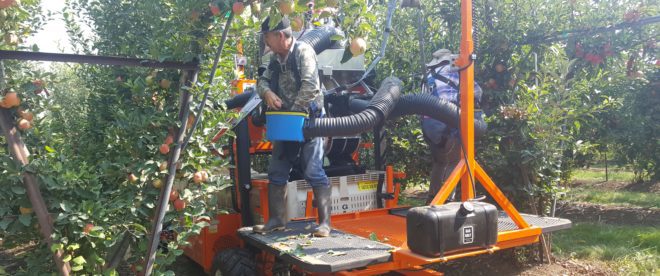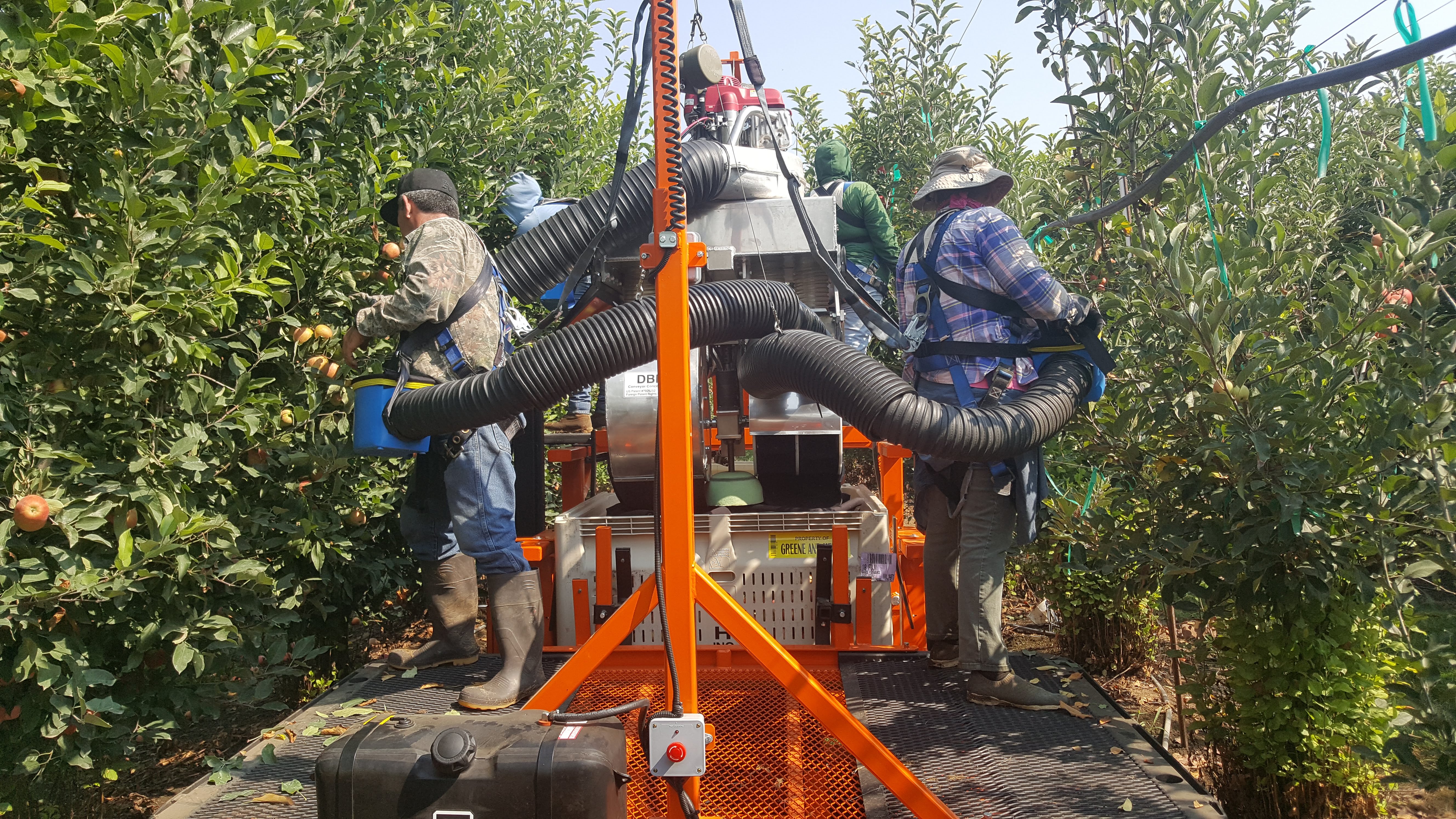

Mar 18, 2019Apple harvests ripe for automated help
Meet the Cyclone, a system of vacuum tubes that takes apples from human pickers, gently filling bins as it propels itself through the orchard.
The Cyclone is the fruit, so to speak, of a partnership between East and West apple-growing regions. The vacuum system, from Conklin, Michigan’s DBR Conveyor Concepts, is the result of 10 years of development, while the bin-handling, self-propelled picker platform it’s married to is from Automated Ag Systems, based in Moses Lake, Washington.
More pieces could be coming: Automated Ag President J.J. Dagorret said that he hopes to try out robotic pickers with the Cyclone.
Researchers, equipment dealers and engineers are putting it all together: Technology, modern orchard architecture and the persistent difficulty of finding seasonal labor for harvests make apple orchards ripe for automatic help.
Apple harvest auto-assist projects include everything from mechanical tree shakers to robots trying to actually pluck apples off the tree.
He Long is an assistant professor in the Department of Agricultural and Biological Engineering at Pennsylvania State University’s Research and Extension Center. He served as a research engineer on tests of mechanical harvesting (shake and catch) projects for apples and cherries and was involved in machine design, fabrication, and field tests.
The main drawback for mechanical harvesting is the fruit quality, but Long said with more uniform tree architecture and localized harvesting, it shows some promise for growers with certain varieties.
Reaching for robotics


Beyond mechanical harvesters, robotics seems more feasible each year.
“As the tree architectures become more and more uniform and simple (2D structure), as well as the development of sensing and robotic technologies (the advancement and also the cost), the use of robotic/automated picker for fruit harvesting would be possible,” Long said. He broke it down to parts: “For a robotic picker, fruit accessibility in the tree canopy, a machine vision system for fruit detection and a robotic actuator for fruit picking would be three major components.”
While the Cyclone so far doesn’t have the robotic or machine vision components, the rest of the vision is functioning. The DBR suction unit sells for $45,000, and with an Automated Ag platform to put it on, the total cost is around $100,000 or more.
The self-propelled platforms pick up apple bins, gently and gradually fill them and then set the filled bins on the ground in the orchard row.
“What’s unique about my system is the bins pass through it,” Dagorret said. He’s already sold a few Cyclones, and anticipates building 10 more in 2019, even as he seeks to audition robotic pickers.
“We still use people right now,” he said.
The Cyclone’s automation, as far as it goes, still shows value: Workers don’t have to shoulder and repeatedly empty heavy canvas bags full of apples. And they aren’t climbing up and down ladders.
“It’s safer, too,” Dagorret said. “It takes a lot of the work out of it. It’s quite a bit faster.”
Meanwhile, robotics technology continues to advance.
FFRobotics


for the 2019 harvest. Photo: FFRobotics
An Israeli company, FFRobotics, has developed a complete robotic harvester.
“The harvester is automated by (a) dedicated vision system, operating system and robotic system,” said Gad Kober co-founder and vice president of business development of FFRobotics.
The self-propelled platform has 12 robotic arms, six on each side. It enters a row, stands in front of trees (one or two on each side), takes a picture, identifies the location of the fruits on the trees and determines color and size (grower’s preset criteria) of each fruit to be picked/left on the tree.” The automatic system then sends arms to pick the fruit and lays it on a conveyor belt to the apple bin.
“No human touch at all,” Kober wrote in an email. One human supervisor monitors the machine’s overall activity and directs it to the entrance of each row.
The last two years’ tests have been conducted in the largest apple orchards in Israel, he said. Final 2019 season tests will take place simultaneously in Israel, Canada, Washington state, elsewhere in the U.S., and France/Italy.
“We will have a few harvesters available for early adopters by the beginning of the 2019 harvesting season,” Kober said. “Serial production (is) expected to begin by 2020.”
He said one of the difficulties has been convincing growers the hardware is worth the investment.
“Taking into account that the harvester replaces between 20-25 pickers per day, and a harvesting season of (about) 80 days, it would appear that one harvester would be justified to pick fruits in an orchard size of 125 acres,” he said. “With diminishing availability of human laborers, which is now becoming more and more evident around the world, a grower will eventually have to decide whether to adopt automated pickers or abandon his profession altogether.”
Abundant Robotics


Abundant Robotics, based in Hayward, California, also is working on a robotically automated apple harvester.
“It’s a complete system analogous to a combine for orchards,” said CEO Dan Steere.
“What we’ve built are self-contained, self-propelled systems that drive down orchard rows, recognize fruit, and as they recognize fruit, they decide if it’s ripe. And then if it’s ripe, robotics is used to pick the fruit, and robotics uses vacuums to pick the fruit off the tree. Then we carry that fruit to the orchard bins, and fill the bins.”
A video of Abundant’s picker in action turned heads a few years ago, but Steere said the footage is now outdated.
“There aren’t really any videos out there of our recent systems,” Steere said. “There’s some video on the Internet of some prototypes we did a couple of years ago, but things have progressed since then.”
He said Abundant is getting close to a commercial release but hasn’t shared a timing schedule for that. Abundant and its parent company, SRI International, have been working on the machine for about five years, Steere said. Testing continued through the 2018 harvest.
Steere said Abundant’s machine would be able to function in any modern tall spindle, vertical or angled orchard, with “a full range of commercial varieties.” He hopes the device can be priced for all growers.
“This type of automation will be accessible to growers across the industry,” he said. “It won’t have to just be a huge operation to work with the automation we’re bringing to market.”
Some growers remain skeptical.
“It’s up to us to prove to them that we’ll do what they need more effectively,” Steere said. “I think we’ll be in a good position to be able to do that.”
Destination: Innovation


improving this harvest-assist system. Photo: Gary Pullano
New capabilities keep cropping up. Renfu Lu, a USDA-ARS research leader housed at Michigan State University’s East Lansing campus, has been working on a harvest-assist machine, and spoke about his research at the recent Great Lakes Fruit, Vegetable & Farm Market EXPO in Grand Rapids, Michigan. A unique feature of his project is the ability to do in-field sorting of apples at a high rate of speed.
“We want to be able to handle nine apples per second,” he said during his presentation.
New technologies also make handling apples easier.


“With new soft, robotic technology, there now is a capability to be able to grip something that’s more delicate without destroying it,” said Bob Doyle, vice president of the Robotic Industries Association.
The advent of automation seems to have only just begun.
“What we’ve seen – the struggle with American farmers to find enough workers to pick a ripe product in the field – the opportunity is great for these technologies,” Doyle said. “And as they improve and the return on investment gets better, I think we’ll see more and more farmers and processors integrating robots and other automation applications.”
– Stephen Kloosterman, FGN Associate Editor
(Editor’s note: This is the first in a
series of stories in which FGN will explore
emerging technologies impacting specialty
crop operations).














